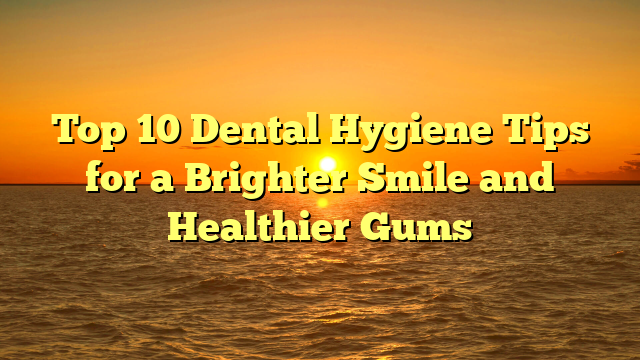A healthy mouth isn’t just about pearly whites—it’s also about strong, pink gums. That’s why adopting the right dental hygiene tips for healthy gums can transform your oral health. Let’s explore ten expert-backed tips that lead to a brighter smile and gums that stay firm and infection-free.
1. Brush Twice Daily – The Golden Rule
Brushing your teeth morning and night is a fundamental habit that prevents cavities and gum disease. But it’s not just about doing it—it’s about doing it right.
Use fluoride toothpaste: Fluoride strengthens tooth enamel and reverses early signs of decay. Always check for ADA (American Dental Association) approval on your toothpaste.
Technique matters: Use gentle circular motions, and don’t forget your gum line. Brushing for two minutes, twice daily, is ideal. Overbrushing or using a hard-bristled brush can wear down enamel and hurt your gums.
2. Don’t Skip Flossing – Clean Between the Teeth
Flossing removes plaque and debris that brushing can’t reach, especially under the gumline.
Choose the right tool: Whether it’s traditional floss, a floss pick, or a water flosser, consistency is what counts. Water flossers are especially helpful for those with braces or sensitive gums.
Timing tip: Floss before brushing to loosen up particles, making your brushing more effective.
3. Use Antibacterial Mouthwash
Mouthwash isn’t just for fresh breath—it fights bacteria and helps prevent gum inflammation.
Pick the right type: Look for alcohol-free mouthwashes with antibacterial properties like chlorhexidine or essential oils. These help reduce plaque and gingivitis.
Use after meals: Swishing for 30 seconds after brushing or eating reduces bacterial buildup and keeps your breath fresh longer.
4. Maintain a Healthy Diet
What you eat can directly impact the health of your teeth and gums.
Gum-friendly foods: Leafy greens, dairy products, apples, and nuts help clean teeth and provide essential nutrients like calcium and vitamin C.
Avoid sugary snacks and acidic drinks: These lead to plaque buildup and enamel erosion. Swap sodas with water or unsweetened tea, and choose fresh fruits over candy.
5. Stay Hydrated for Saliva Production
Saliva plays a huge role in defending your teeth and gums.
Why it matters: It washes away food particles, neutralizes acids, and helps with digestion. Dry mouth increases your risk of cavities and gum issues.
Best beverages: Water is the top choice. Avoid drinks that cause dry mouth like alcohol or high-caffeine sodas.
6. Replace Your Toothbrush Regularly
Your toothbrush isn’t meant to last forever.
Timing is key: Replace your brush every 3-4 months—or sooner if the bristles are frayed. Worn-out brushes can’t clean effectively.
Electric vs. manual: Studies show that electric toothbrushes with oscillating heads can remove more plaque and reduce gum disease better than manual ones.
7. Schedule Regular Dental Checkups
Preventive care is a game changer in oral health.
What happens during a cleaning: Your dentist will remove plaque and tartar that you can’t reach at home, examine your gums for disease, and give you tailored advice.
Go every 6 months: Even if your teeth feel fine, problems can brew silently below the gumline.
8. Stop Smoking for Better Gum Health
Smoking is one of the leading causes of gum disease.
The dangers: It weakens your immune system and makes it harder for your gums to heal. Smokers often develop deeper gum pockets and more severe periodontitis.
How to quit: Nicotine replacement therapies, counseling, and apps like Quit Genius can provide daily motivation and tracking.
9. Don’t Ignore Bleeding Gums
If your gums bleed when you brush or floss, don’t assume it’s normal.
Possible causes: Early signs of gingivitis or even more advanced periodontal disease. Left untreated, it can lead to tooth loss.
See a dentist: They’ll assess the cause and recommend treatment—scaling, root planing, or medication.
10. Use Proper Brushing and Flossing Tools
Your tools make a big difference in your hygiene routine.
Brush heads and bristles: Always opt for soft bristles to protect enamel and gums. If you have sensitive teeth, use specially designed heads.
ADA Seal: Whether it’s floss, toothpaste, or a toothbrush, look for the ADA seal—it means the product is safe and effective.
Frequently Asked Questions (FAQs)
Q1: How often should I visit the dentist for a cleaning?
A: Every 6 months is ideal, but those with gum disease may need more frequent visits.
Q2: Can mouthwash replace brushing or flossing?
A: No, it complements them but doesn’t replace the physical removal of plaque by brushing and flossing.
Q3: Are bleeding gums always a sign of gum disease?
A: Not always, but it’s usually a sign of inflammation or improper cleaning. It should be evaluated by a dentist.
Q4: What’s the best toothbrush for gum care?
A: Soft-bristled, electric toothbrushes with pressure sensors are great for gentle yet effective cleaning.
Q5: Is flossing really necessary if I brush well?
A: Absolutely. Brushing misses up to 35% of your tooth surfaces—flossing covers those gaps.
Q6: What foods are worst for gum health?
A: Sticky candies, sugary sodas, and acidic drinks are the biggest culprits behind gum problems.
Conclusion – A Lifetime of Healthy Smiles
Good dental hygiene isn’t just about avoiding cavities—it’s about keeping your gums strong and infection-free. These dental hygiene tips for healthy gums are simple to follow and incredibly effective when practiced consistently. A radiant smile and fresh breath start with small daily habits. Stick with them, and your gums will thank you for a lifetime.
